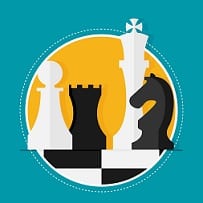
With all the changes that went through from Chaturanga to Chess, even the pieces took up different names.
From the ‘four limbs’ constitution of the ancient Indian game with the infantry, elephantry, cavalry, and chariots to the modern rooks, knights, bishops, kings, queens, and pawns, much has changed.
However, not every aspect of Chaturanga changed throughout the centuries. The difference in the movements of pieces, for example, was kept.
Being an indicator of that piece’s importance and strength, the movement range is a key factor in strategies and combinations in openings, middle, and endgames.
The Queen
A good example of the importance of the movement range is the queen, which, as we know, can move as many squares as are free in any direction. Due to having the largest range, the queen is seen as the most powerful piece on the chessboard.
However powerful, the queen is still second to the king, as only by checkmating the king, apart from forfeits or repetition of illegal moves, of course, can a player win a game.
That is also the reason why in almost every promotion ever gotten, the pawn was exchanged for a new queen.
A promotion happens whenever a pawn reaches the farthest rank from his starting position, where it can be exchanged for a figure piece, which means a rook, a bishop, a knight, or a queen.
Since the latter is the most powerful piece, we rarely see a different promotion. The movement range is also what allows moves such as forks to be performed.
Royal Fork In Chess
A fork happens when a piece has the opportunity of capturing more than one piece in the same move. There is a myriad of situations in which forks can happen during a match.
A simple example of a fork is when the queen is in 4d and one of the opponent’s knights is in b6, and one of the pawns is in g7. In that situation, the queen can either capture the knight or the pawn.
There are many kinds of forks, depending on the pieces that are found in vulnerable positions. However, when the pieces that are up for capture are the king and the queen, the fork is considered a royal one.
Despite the higher importance of the royal fork, none of the other kinds should be overlooked. Forks are extremely useful in gaining material difference and enforcing attacking treads.
Due to its larger movement range, the queen is the piece that normally is more prone to cause a fork. The knight normally comes second in the list due to its ability to jump over pieces and reach apparently secured squares.
When playing, keep an eye out for forks, whether for performing or avoiding them, as they normally cause great damage. Lastly, seek fork formations, particularly in endgame stages, in which the damage can be the highest.
Remember the importance of the queen and use a fork to cause your opponent to lose their most powerful piece.


